How to buy a quality rug
Here's some information and a little story from a recent visit.
The biggest factor in a rug's quality is being hand knotted. Familiar territory, really, for men used to thinking of hand-sewn shoes and hand-padded jackets.
It's fairly easy to tell if a rug is hand knotted. Just look on the back, you'll see the squares that make up the pattern are filled with slightly irregular knots of the wool (below).
A machine-woven rug is a lot more uniform.
Actually, if we go back a step, I'm assuming any rug you'd be looking at would be wool.
Perhaps silk, if that's your taste, but certainly not synthetics. Wool looks better, cleans better, and ages more attractively. It can also be repaired effectively.
"After those two factors - fibre and hand knotting - we get into attributes that are aesthetic and a bit more personal," says Bruce Lepere. This piece was born out of a chance conversation with Bruce and his team, Iliya and Matthew, in Liberty's last month. (Pictured below, left to right.)
"Western taste tends to be towards wools in colours that are rich but not necessarily bright," Bruce continues. "People want something that looks old and traditional."
"Eastern taste is often for shiny, intricate silks," Matt continues. "An Iranian coming in here is much more likely to want something that looks fresh and new."
Liberty Oriental Carpets (actually a separate business to the department store that houses it) doesn't sell many of this type of rug.
Most of its stock is tribal rugs, which means ones woven by individual people or families, in their homes, according to their tribal traditions.
It's a cottage industry basically, like tweed weaving on Harris and Lewis, or the hand framing of shetland sweaters.
The alternative is often called a 'city' rug, as it is woven in towns or cities, by large groups of weavers, and usually to the same pattern under the direction of one master weaver.
"This means every rug is the same," says Bruce. "Whereas women weaving at home, from similar traditions but all taught by different ancestors, will do things their own way."
Given it also takes that woman one to two years to complete a rug, little variations also creep in over that time.
Another effect of that long weaving period is that the yarn colour varies.
With a tribal rug like this the yarn is usually dyed by hand, with colours matched by eye, and only enough is done each time for a few weeks of work. It would be too expensive to do two years’ worth at the start.
This means that colours will vary across the rug. In the example above, for instance, you can see that the colour of the strip with white, curly figures on it varies along its length. One rectangle is very dark brown, the next mid-brown, and the next slightly darker brown.
You see this variation particularly in red areas of rugs, because the pigment varies more naturally. The effect is also artificially reproduced in lots of modern rugs.
"How much people like this variation is again a matter of taste," says Bruce. "But a little bit, across a patch of colour, gives the rug texture and life that you never get with flatter, mass-produced rugs."
So hand dying, of hand-spun yarn, is another attribute the team would include a list of characteristics of a good rug. That's partly because of the attractive, natural variation, but also because of the way the rug ages.
Which brings us onto an interesting area, in terms of preference and aesthetics.
The current fashion is for faded rugs. Ones that look look old and very worn in. New shops and clubs are full of them.
The thing is, what this normally indicates is that the rug is poor quality. “An inferior rug won’t be woven as densely, or knotted by hand,” says Bruce, “which is what causes it to wear down and fade quickly.”
(By the way, density of weaving is another to add to the list of quality attributes.)
To a purist, a faded rug is a damaged rug. There’s nothing wrong with fading over a good period of time but, rather like patina on shoes, this is something personal, that you create yourself.
“The worst thing of all is the trend for over dyeing - taking those cheaper faded rugs and then dying the whole thing one colour, like green. That to me is just graffiti,” says Bruce.
Not everyone will be as extreme about over dyeing as Bruce is. But it’s hard not to appreciate the beauty of these handmade, tribal rugs when you see them in person. And just like handmade shoes, the quality makes them easier to repair.
The team like to tell the story of a Scottish client who came in with a very precious rug, with a large hole in it. There had been a fire at his castle, and a piece of the ceiling had fallen on top.
The master repairer came, took it away, and the rug was delivered a few weeks later. “It look us a long time to identify the repaired area,” says Bruce. “Finally, we all pointed it and remarked how seamless the work was.”
Then the repairer arrived, and asked them what they were all looking at. “We said we were admiring the work, how it was almost unnoticeable,” says Bruce. “Only for the repairer to say, ‘but that’s not the repair, it’s over here’ indicating somewhere different entirely.”
It was lovely talking to Bruce and the team. I’ve been a bit intimidated in the past, given I know nothing about rugs, but they were unpretentious, helpful, and mostly just happy to explain everything about their work. It helped that it turned out Matt was a PS reader as well.
“I’ve been here since the Liberty family were here,” says Bruce, “and I’d even dare to say we’re more Liberty than Liberty. We’re more old-fashioned. The store was founded to import Eastern crafts and sell them in the West, to showcase that work, and we're continuing that tradition."
The old images of what Liberty's used to look like - shown in the black-and-white photography below - are wonderful.
The current department specialises in antique tribal rugs from around 1880 to 1930. Before that, rugs are apparently rarer and prices go up exponentially.
After then, the quality usually wasn’t as good, and of course they are no longer antiques, not being more than 100 years old. But they do sell new works as well - such as the large red piece below.
Antique rugs are mostly in the region of £2,000 to £5,000. Smaller and new ones can be cheaper, but not necessarily. Either way, it’s always worth talking to the team, as there is little information on the website.
I didn’t buy anything, as our house is already pretty full with new, thankfully hand-knotted rugs. But there are gaps here and there, and I wish I had taken the time to go to Liberty with all those earlier needs, if only to learn.
“The state of the market right now is not a good one,” says Bruce, who also lectures on carpets for the V&A. “Until 10 years ago John Lewis was our biggest competitor, the largest seller in the land, but most of what they sell is now machine woven or even printed.”
The rug market is also full of euphemisms (just like menswear) such as pieces that are described as ‘hand finished’. “Which basically means they’ve sewn a fringe on the end by hand,” says Matt.
The fringe, by the way, is often a good thing to look at to see what the rug is made of (second image below). That’s the warp of the woven material, so you can see what runs through everything else.
One more for the list of what makes a good rug.
You can read much more about Liberty Oriental Carpets, and see examples, at libertyorientalcarpets.com. There’s also a couple of videos talking about the craft in person.


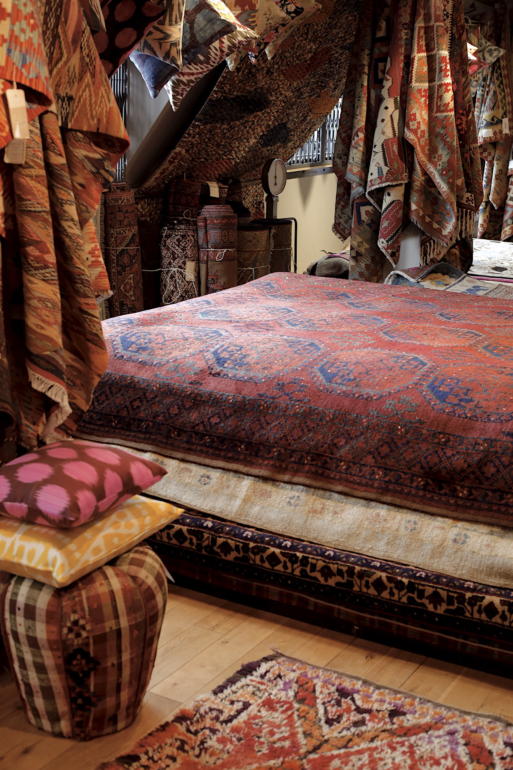
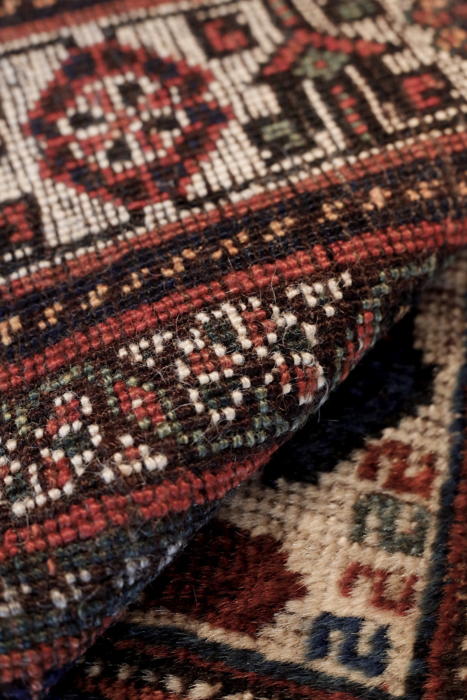
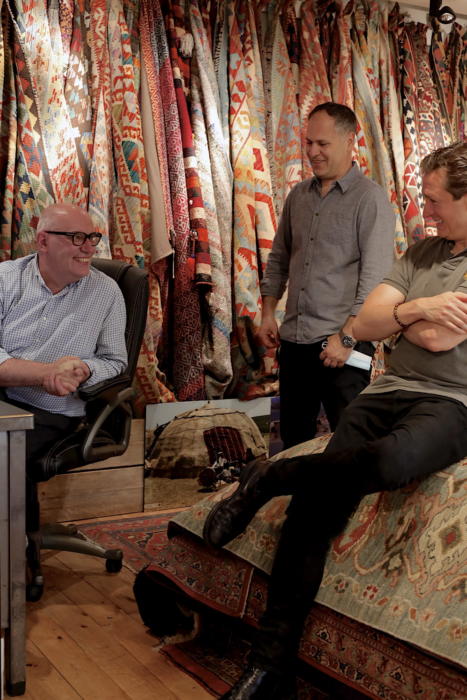
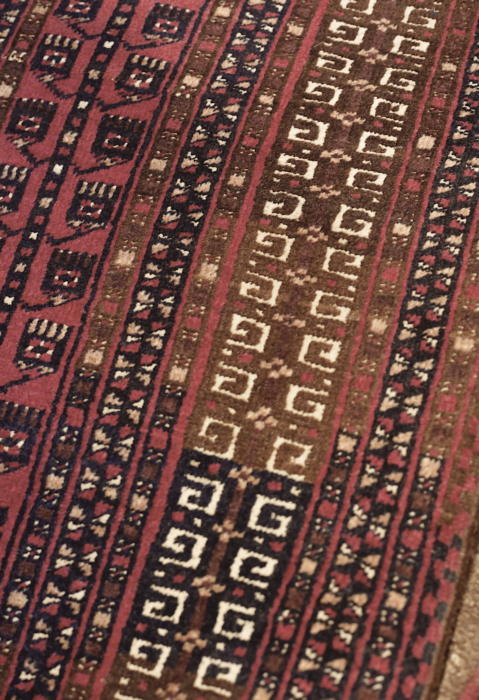
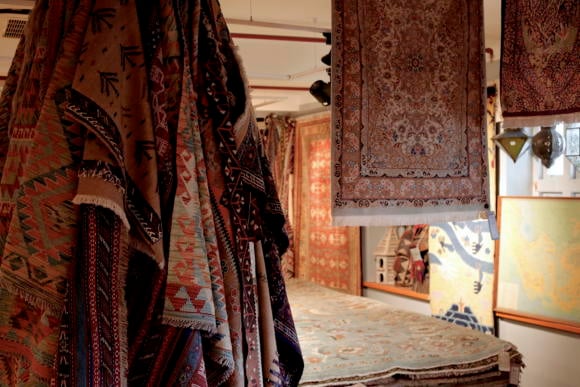
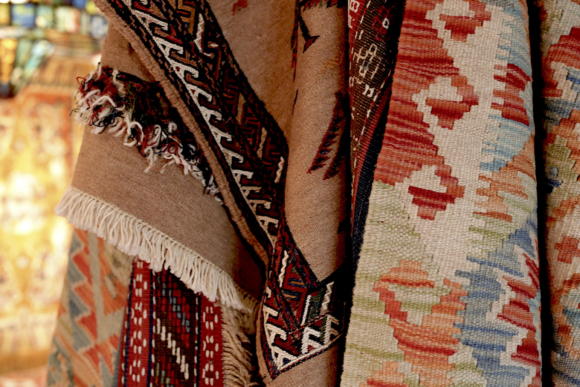
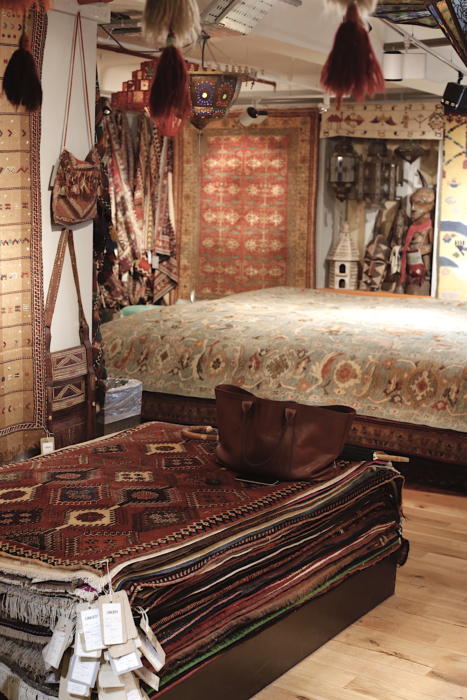
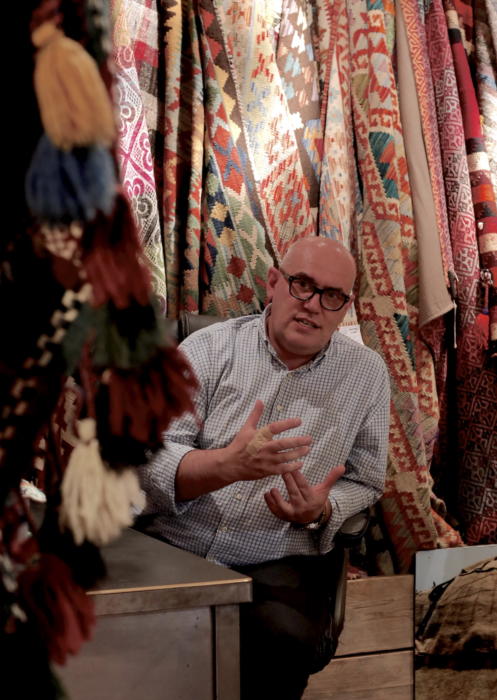
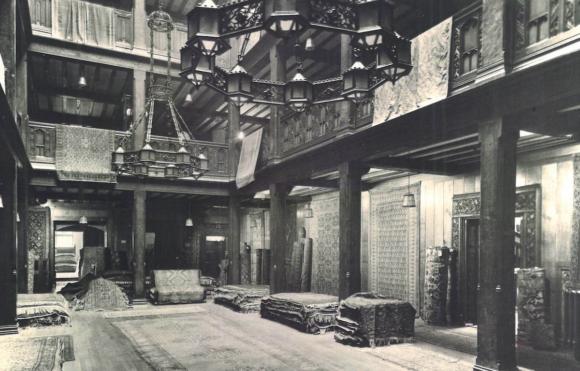
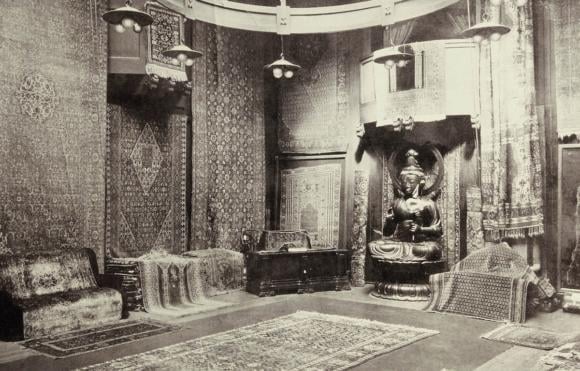
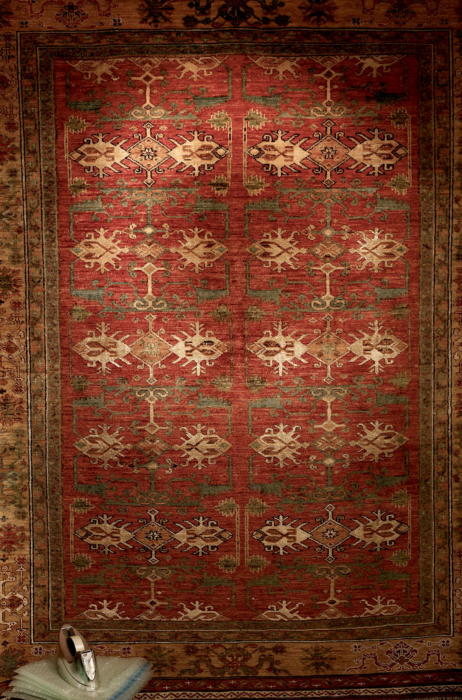
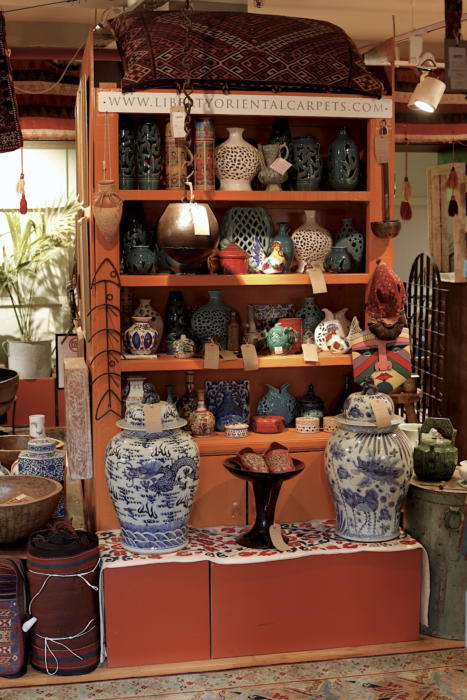
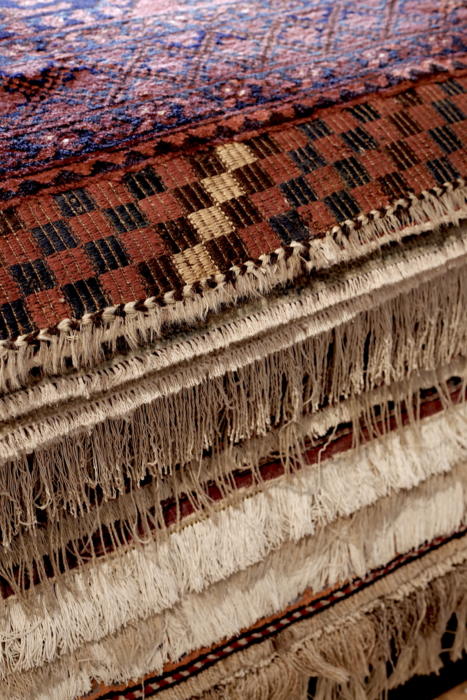


























Simon – where did you buy your rugs from of not Liberty?
Rugs of London. There were good, but I would get the advice of the Liberty’s team in future
It’s also fun to pick up rugs when you travel. I got a nice one in Istanbul and another one nice ones in Egypt. Brings back good memories of each of those trips.
Rugs are, to use Simon’s terminology from the recent post, a secondary interest of mine. I think they’re beautiful, but they are a bit like watches – this can be an expensive hobby if you don’t educate yourself. And that education is hard to come by. There aren’t as many online resources for the new buyer as there are for watches. And not everyone (including me) wants to be a full-on collector. The best thing is to find a dealer you can trust and establish a relationship with, which is the second hardest part of buying a rug (the first is paying for the thing!)
Nicely put Craig. For me the main reason that relationship is so key, is that if you talk to someone who understands and loves textiles like this, they will make you understand why it is special. That’s the biggest thing that was missing before with me, with online purchases
Interesting. I would also be interested to know more about the rugs concession as a retail business. Presumably more reliant on long term customer relationships and very significant one-off purchases – more antique dealer than homewares retailer per se?
On a (somewhat) related note, I am aware that Liberty are undergoing restoration work on their building recently, and I found the level of craft that goes into that work fascinating. Such a beautiful building (in its own way) and great to see it so lovingly restored. Given the focus on craft, I thought other PS readers might also be interested – see https://www.youtube.com/watch?v=RHdyJivzjGE
It always adds something when good retailers are located in nice buildings. While I wouldn’t say that the Liberty building is necessarily to my tastes architecturally, it is still a beautiful and interesting building with lots of lovely details to be discovered over time.
I think you’re right on the first point Oliver. Certainly the team have some very good clients, and the work is mostly travelling to where the rugs are made, to source directly
I remember looking to buy a silk rug from Harrods many years ago and heard the best sales ever when asking about its longevity. The salesman said it would last at least a century….
Interesting post. Indeed a lot of what is appealing about clothes also applies to rugs. Stylewise, I find that traditional Persian rugs don’t easily fit into the kind of interior nearly all “stylish” people have these days (i.e., modern furniture eclectically mixed with some antique pieces). They are visually overwhelming and often look dated, no matter how exquisite on their own. Hence probably the preference for faded looks – though Ziegler style rugs have for a long time been made using rather subtle colors. I find that flat Kelim-style rugs (actual Kelims, some Moroccan rugs, etc.) are much easier to fit in.
I don’t see the point about overdyeing. Those carpets are usually somewhat crappy anyways, so what’s wrong about giving them a second life for people who like that look instead of throwing them away. To me that’s a little like criticizing pre-washed jeans or Italian field jackets because they don’t look like the original from WWII.
Thanks Simon for the kind words, lovely to meet you and we look forward to seeing you soon for that rug!
Cheers Matt. Don’t worry, I’ll be back
Great post, thank you. As a fan of rugs, I like to look at them, but don’t know a tremendous amount about them although I am pleased to write that I was in a rug shop about a decade ago and learned the distinction between tribal and city rugs. I had always had a preference for tribal patterns, but did not know it was actually a specific category. As do you, I have a house basically full of them, but I would say they fall into the vintage, rather than the antique category (although I will admit I have a new, artificially faded one in a small entry hall that I quite like – I’ll have to see if I can determine if it is over dyed, but definitely not hand-knotted).
Concerning the over dyeing process, I conceptually understood what you wrote, but I couldn’t quite visualize it so I looked it up. I take Bruce’s point. Selecting an older rug and over dyeing it to mute it down and make it more useable in the ever popular mid-century modern interior works from a marketing perspective, but really does diminish the integrity of the original. I suppose new rugs are also made to look like this at the outset.
At any rate, I enjoyed learning something new today and would welcome any random posts of this nature as the spirit moves you.
P.S. Vintage photos are fantastic!
Thanks, nice to hear.
And yes, those old shots are amazing aren’t they? Remind me how Liberty’s was originally set up, as this emporium bringing in everything crafted from the East
One of the wonderful things about oriental rugs is how they tend to get passed on from generation to generation. My grandparents’ house was filled with them, and my parents bought quite a few in the late 70s / early 80s when they were really cheap. (Back then in the US, everyone would cover hardwood floors with wall-to-wall). When my grandparents passed, I received several of their carpets and several of my parents (which they passed on to make room for my grandparents’ carpets). Walking around my house, I get reminded of memories from childhood days just by looking at the various carpets.
Amazing, lovely to hear
Excellent article, Simon. Educational and inspiring.
Cheers Andy
I’ve collected antique rugs and carpets for +25 years. I appreciate that there is a lot to learn.
There are a few apparent ”errors” in what you write here Simon, related to quality. A densly knitted rug being of higher quality is an example. A densly knitted rug is more hard wearing, no doubt. But is that the only, or even an important, aspect of quality? No, it’s not, similar to if a higher quality shirt is more hardwearing than a lower quality shirt.
Quality of wool, balance of color, artistic expression are far more important in judging quality.
Density is very related to type of rug. For Isfahan, Keshan or similar type of ”manufacture” rug, density has merit in assessing quality. It is however not an important indicator of quality in itself.
For tribal rugs, density has nothing to do with quality. A lovely £25000 antique Kazak is coarse. It has a soft structure, with both warp and weft in handspun wool. It is not at all hardwearing. Still of top quality.
Fringes as indicator of quality? Well, again, not in itself. Tribal rug? Quality = handspun wool most often. City rug/atelier/ manufacture rug? Quality = machine spun cotton.
Quality, handmade rugs with quality materials such as handspun wool with organic/natural colors is unfortunately a dying art and new ones are very rare to find. Check out Rewoven Rugs (@rewovenrugs on Insta) for a company trying to breath life in this art again.
Hi,
First of all, bear in mind Bruce and the team provided and checked all this information. I trust their expertise, but it also speaks to certain preferences.
Your point about quality is surely a subjective one – it’s not right or wrong, it just depends what people prefer. And being hard-wearing is likely to be high up the list with most buyers of rugs, unlike a dress shirt.
Of course, the article also doesn’t say that being densely woven is the only mark of quality, so I’m not sure why you suggest that. And it’s a general point, not related to the specific examples here. It is true, in general, that cheaper rugs are often more loosely woven and it is therefore something to watch out for.
The point about fringes is similar – it’s a general point for the novice to this (as the whole article is) and something to watch for in a cheap rug, to see the warp. The article also talks about handspun wool, and about natural colours.
I don’t think we’re really talking at odds, this is just great additional information on subtleties and preferences, which is great.
Thank you for the tip on Rewoven
This is well-timed as I am about to replace some awful carpeting in my home with hard wood, and will soon need several fairly large area rugs. I already knew it would be costly, so my main takeaway from this article is that I have quite a bit of homework to do.
As others have commented, it’s not easy to learn effectively about rugs from the internet, but there’s a well-established literature on the subject and the inter-war volumes tend to be very informative and not linked directly to selling you things. Also, museums are treasure houses for learning which patterns you like — the Met in NYC, the V&A in London, various ethnographic museums both there and in Berlin and Paris. I was lucky enough to inherit an 1860s Persian and a very small and even older tribal carpet of prayer rug size. They’re among the oldest things I remember from childhood and it’s humbling to think that four generations of my ancestors grew up on those rugs, which made it through the Blitz and multiple sea voyages as well. They’re quite worn, as generations of children and dogs did their best to damage them, but apart from general fading, not always evenly, and a couple of patches where some of the wool is worn down visibly, they have another fifty years or more left in them. I think all the advice in this article is spot on, and I have to say the currently fashionable artificial aging is absolutely horrible looking on new rugs. But reliable dealers, whom you will learn to recognize after a couple of conversations with con-artist salesmen that are rife in the rug business, often stock very good antique rugs, and those from the 30s, 40s and 50s can be quite reasonable. Let me echo Simon: If one wants something that looks worn and well-aged, get the real thing. It won’t just be authentic (in the meaningful sense of that over-used word) it will be instantly recognizable as such.
Really nice article, which I think fits well with PS and all it stands-for.
I have a real hankering for a few, XL antique or vintage rugs. Style is of course subjective, but I think they sit just as nicely as an item of contrast and conversation in a modern home, as they do in an older place.
I’m worried about my naivety though as it is quite a minefield, so I’m concerned about making a bad purchase, especially when you’re likely looking at £5k + for a larger piece.
This therefore is very timely and perhaps Bruce and the team are a good place to start (and hopefully end).
I’d certainly say so Ant, yes. They’re one of the very few teams in interior decoration that have felt to me like the kind of brand/shop/craftsman you get on PS generally
This was great Simon. As a fellow rug enthusiast (writing this from on top of my hand woven, not antique Heriz) it was fun to read your connections between handcrafted clothes and handcrafted rugs.
Lovely, good to hear Peter
I do love oriental rugs like these, but havent had the chance to invest, since I am still havent bought the home where I wanna raise my kids and grow old in. Until I have that place I find it hard to buy rugs of the right size, since this varies with the size of the room and also its layout. Perhaps I am overthinking it, as a large rug will always come in handy. But I find also that the colours need to be right. There are so many different shades of red, for instance, in these rugs, and not all are the right kind, that goes with all different kinds of furniture.
I think you’re right on colour – size won’t matter as much, but you don’t want furniture and rugs that don’s work together
Oriental rugs, rhymes with drugs. Love ’em. Like a garden in your living room and wonderful to think they are still made by hand. Bought some from Liberty and some on line with reasonable success. So adaptable but now I have run out of floor space!
You haven’t mentioned it but it bears emphasizing: not all “wool” rugs are all wool. Many will use cotton too. Cotton is to be avoided if one wants a rug that lasts. One can often identify cotton content by checking the fringes. If one sees cotton fringes, then the rug is partly cotton and should be avoided or, at least, one should never pay for it the price of an all wool rug.